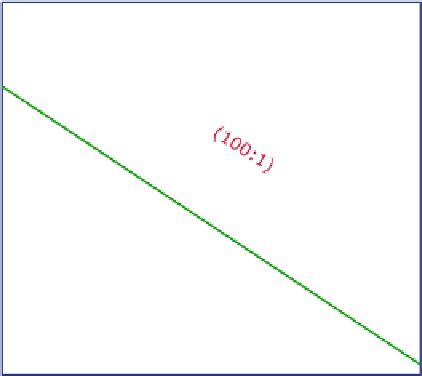Geoscience Reference
In-Depth Information
Fig. 4.15
Example
calculation of the viscous/
capillary ratio for a layered
system as a function of
length scale, for selected
permeability contrasts
(Redrawn from Ringrose
et al.
1996
,
#
1996, Society
of Petroleum Engineers
Inc., reproduced with
permission of SPE. Further
reproduction prohibited
without permission)
Tidy up text elements
10000
Viscous-dominated
100
1
0.01
Capillary-dominated
0.0001
0.01
1
100
Heterogeneity lengthscale (m)
[Distance between layers of contrasting permeability]
very high to override capillary effects). Note, how-
ever, that the pressure gradients will vary as a
function of spatial position and time and so in
fact the Viscous/Capillary ratio will vary - viscous
forces will be high close to the wells and lower in
the inter-well region.
An important and related concept is the capil-
lary number, most commonly defined as:
recognised for some time. Haldorsen and Lake
(
1984
) and Haldorsen (
1986
) proposed four
conceptual scales associated with averaging
properties in porous rock media:
• Microscopic (pore-scale);
• Macroscopic (representative elementary volume
above the pore scale);
• Megascopic (the scale of geological heteroge-
neity and or reservoir grid blocks);
• Gigascopic (the regional or total reservoir
scale).
Weber (
1986
) showed how common sedimen-
tary structures including lamination, clay drapes
and cross-bedding affect reservoir flow
properties and Weber and van Geuns (
1990
)
proposed a framework for constructing
geologically-based reservoir models for different
depositional environments. Corbett et al. (
1992
)
and Ringrose et al. (
1993
) argued that multi-scale
modelling of water-oil flows in sandstones
should be based on a hierarchy of sedimentary
architectures, with smaller scale heterogeneities
being especially important for capillary-
dominated flow processes (see Sect.
2.3.2.2
for
an introduction to hierarchy). Campbell (
1967
)
established a basic hierarchy of sedimentary
features related to fairly universal processes of
C
a
¼
μ
q
ʳ
ð
4
:
13
Þ
where
μ
is the viscosity, q is the flow rate and
ʳ
is
the interfacial tension.
This is a simpler ratio of the viscous force to
the surface tension at the fluid-fluid interface.
Capillary numbers around 10
4
or lower are
generally deemed to be capillary-dominated.
4.3
Multi-scale Geological
Modelling Concepts
4.3.1 Geology and Scale
The importance of multiple scales of heterogene-
ity for petroleum reservoir engineering has been
































